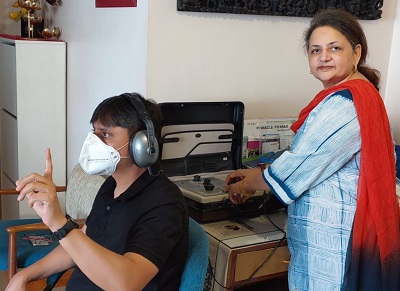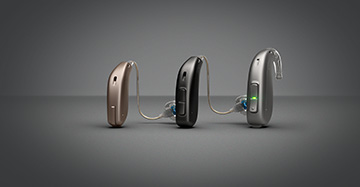Audiologic Evaluations – Audiogram – diagnostic hearing tests
If you or your child has been referred for an audiologic evaluation, it means that hearing loss needs to be ruled out or further examined. The audiogram is done to determine if hearing loss is present, and if so, to detail the type and severity of the hearing loss. It also may provide insight into the cause of the hearing loss as well as provide guidance for the audiologist in making appropriate treatment recommendations.
What Tests Will Be Done?
The specific tests done during the evaluation will depend on the patient’s age, and what is known already about their hearing status. These various tests will determine the degree of hearing loss, the type of hearing loss, and the conditions of the ear canal and middle ear. The audiologist will determine if the hearing loss is conductive (middle/outer ear problem) or sensorineural (inner-ear problem or central-processing difficulty of the brain). A diagnostic audiologic evaluation includes pure-tone testing, bone-conduction testing, and speech testing.
Pure-tone air conduction testing determines the quietest tones that a person can hear at different frequencies, low and high. Bone conduction testing is similar to pure-tone air conduction testing. A different type of headphone is used during bone conduction testing. The results will reveal if the hearing loss is originating from the outer/middle/inner ear..
Speech Testing
A speech reception threshold (SRT) test is often used with older children and adults to confirm the results of a pure-tone test. This test determines the lowest level at which the patient can recognize words or speech stimuli.
Additional Tests
The audiologist will also perform otoscopy (examining the ear canal) and tympanometry (test of the middle ear) to determine the health of the ear canal and the middle ear.
Specialized tests exist for infants and young children, as well as children and adults with developmental and cognitive impairments. These more-specialized tests allow the audiologist to test the auditory system when the patient is not able to actively participate in the tests or evaluation. Other tests may include, Auditory brainstem response (ABR) and auditory steady-state response (ASSR) testing
Otoacoustic emissions (OAE) screening:
For children, it is important to have a diagnostic audiologic evaluation whenever a hearing loss is suspected. It is the first step in identifying hearing loss and dealing with it to improve quality of life. Hearing loss in children can cause language and speech delays, learning difficulties at school, and behavioral problems.
What Else Can I Expect During an Audiologic Evaluation Appointment?
The case history and evaluation-audiogram will typically last about 30 to 40 minutes in length. Along with the audiogram, you should generally expect to have time to review the results with the audiologist. He or she can interpret the audiogram for you, answer your questions, provide you with information and referrals as needed, as well as begin planning for treatment, if indicated. The diagnostic audiologic evaluation is a good chance to establish a relationship with your audiologist. Hearing rehabilitation is a process, not a quick fix.
Audiologists are specialists in hearing healthcare and hearing rehabilitation. Never hesitate to ask your audiologist for clarification on the audiogram or further information on anything you do not understand about your ears and hearing . It is important to determine that you need hearing aids. Then allow for sufficient time to discuss your options in the same session or in a follow up appointment.
HEARING LOSS IS A FAMILY AFFAIR
Hearing loss is a family affair. It is recommended that you bring a family member with you to the evaluation appointment. It helps to have another supportive person to help you understand the information and recommendations.
Before taking an audiogram, the audiologist will want to hear about any hearing complaints along with your relevant medical-history. Additionally special attention will be paid to any concerns you have about exposure to noise, tinnitus, and balance problems. Make sure that you take a full list of any medications and supplements you are taking with you to your appointment.
Above all, don’t be afraid to ask questions. You will want to be clear on any information you receive. Hence, you can also find hearing solutions that work best for your lifestyle requirements.
There are many steps that are part of an audiogram. If you suspect that you might need a hearing aid, you will first need to have a hearing test. The audiogram will determine how much your hearing problem impacts your as well as your families’ day-to-day life. A complete history will be taken, and questions will be asked about when and how the hearing loss started, if there is ringing in your ears (tinnitus) and if you experience dizziness along with general health history.
THE RESULTS FROM YOUR AUDIOGRAM
The hearing test will provide the hearing care professional an outline of what sounds you may be missing or hearing, but the personal answers about your daily life and perception about your hearing provide the basis for a more comprehensive hearing evaluation. You may be referred to a medical doctor specializing in disorders of the ear if there are other medical conditions your hearing professional thinks should be addressed before hearing aids are recommended.
If your audiogram reveals a permanent hearing loss, a hearing aid may be recommended. Your audiologist will explain what sounds you cannot hear well and how using hearing aid(s) can help. It is usually at this appointment that you will get to see and touch different styles of hearing aids. In some cases, you may even be able to listen to a hearing aid. Your hearing professional will help choose the best hearing aid(s) in terms of style, features and level of sophistication. This is based on your degree of hearing loss, lifestyle requirements, and financial circumstances. The final decision on which hearing aid(s) is purchased is your choice.
Once you make a decision, the hearing professional may take impressions of your ears if you selected custom hearing aids or behind-the-ear hearing aids that require earmolds. Hearing aids are ordered from a manufacturer. They are then programmed by an audiologist to meet your specific hearing needs per your audiogram. This process can take a few weeks, so do not be disappointed when you do not receive your hearing aids the same day as your audiogram.








